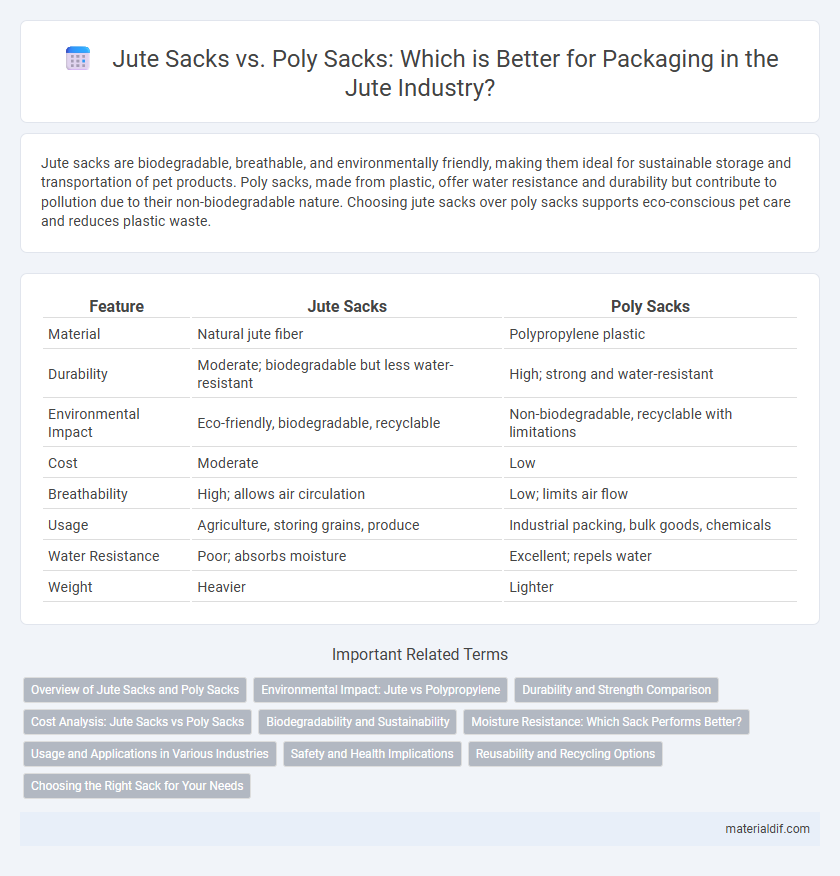Jute sacks are biodegradable, breathable, and environmentally friendly, making them ideal for sustainable storage and transportation of pet products. Poly sacks, made from plastic, offer water resistance and durability but contribute to pollution due to their non-biodegradable nature. Choosing jute sacks over poly sacks supports eco-conscious pet care and reduces plastic waste.
Table of Comparison
| Feature | Jute Sacks | Poly Sacks |
|---|---|---|
| Material | Natural jute fiber | Polypropylene plastic |
| Durability | Moderate; biodegradable but less water-resistant | High; strong and water-resistant |
| Environmental Impact | Eco-friendly, biodegradable, recyclable | Non-biodegradable, recyclable with limitations |
| Cost | Moderate | Low |
| Breathability | High; allows air circulation | Low; limits air flow |
| Usage | Agriculture, storing grains, produce | Industrial packing, bulk goods, chemicals |
| Water Resistance | Poor; absorbs moisture | Excellent; repels water |
| Weight | Heavier | Lighter |
Overview of Jute Sacks and Poly Sacks
Jute sacks are biodegradable, eco-friendly, and highly breathable, making them ideal for storing agricultural products like grains and coffee beans. Poly sacks, made from polyethylene, offer superior moisture resistance and durability but pose environmental concerns due to their non-biodegradable nature. The choice between jute and poly sacks depends on specific storage requirements, environmental impact considerations, and cost efficiency.
Environmental Impact: Jute vs Polypropylene
Jute sacks offer a biodegradable and renewable alternative to polypropylene sacks, significantly reducing plastic pollution and landfill waste. The production of jute involves lower carbon emissions and less energy consumption compared to synthetic polypropylene, promoting a more sustainable supply chain. Biodegradability of jute ensures it breaks down naturally within months, whereas polypropylene persists in the environment for centuries, contributing to long-term ecological damage.
Durability and Strength Comparison
Jute sacks exhibit superior durability and strength due to their natural fiber composition, providing excellent resistance to wear and tear in heavy-duty applications. Poly sacks, made from synthetic materials like polyethylene, offer high tensile strength and moisture resistance but tend to degrade under prolonged UV exposure and heavy abrasion. The choice between jute and poly sacks depends on the specific requirements for robustness, environmental exposure, and reuse potential in packaging and agriculture.
Cost Analysis: Jute Sacks vs Poly Sacks
Jute sacks typically cost more upfront than poly sacks due to their natural fiber composition and sustainable production methods. However, jute sacks offer long-term savings through durability, biodegradability, and reduced environmental disposal costs. Poly sacks, while cheaper initially, may lead to higher overall expenses from environmental fees and shorter lifespan requiring frequent replacements.
Biodegradability and Sustainability
Jute sacks are highly biodegradable, decomposing naturally within months and significantly reducing environmental pollution compared to poly sacks made from non-biodegradable plastics that persist for decades. The sustainability of jute is enhanced by its renewable nature and minimal agrochemical requirements, making it an eco-friendly alternative to synthetic poly sacks derived from fossil fuels. Choosing jute sacks supports circular economy principles and reduces plastic waste accumulation, aligning with growing global efforts toward environmental conservation and sustainable packaging solutions.
Moisture Resistance: Which Sack Performs Better?
Jute sacks offer natural breathability and moderate moisture resistance, making them suitable for dry goods but less effective in high-humidity environments. Poly sacks provide superior moisture resistance due to their synthetic, waterproof material, ensuring protection against dampness and reducing spoilage risks. For applications requiring enhanced moisture barriers, poly sacks generally outperform jute sacks in maintaining product integrity.
Usage and Applications in Various Industries
Jute sacks are widely used in agriculture and food industries for packaging bulk commodities like grains, vegetables, and coffee beans due to their biodegradability and breathability, which help protect contents while reducing environmental impact. Poly sacks, made from synthetic polymers, dominate sectors requiring moisture resistance and durability, such as chemicals, pharmaceuticals, and construction materials, offering better protection against water and contamination. Both sack types serve essential roles, with jute preferred for eco-friendly packaging in natural product supply chains and poly sacks favored for heavy-duty industrial applications where strength and impermeability are critical.
Safety and Health Implications
Jute sacks offer superior breathability and natural biodegradability, reducing moisture buildup and mold growth that can compromise worker safety and product quality. Poly sacks, made from synthetic materials, are less permeable, increasing risks of mold, mildew, and chemical leaching, which may lead to respiratory issues or skin irritation among handlers. Choosing jute sacks supports healthier storage conditions and lowers environmental health hazards compared to poly sacks.
Reusability and Recycling Options
Jute sacks offer superior reusability due to their natural fiber strength and durability, allowing multiple uses without significant degradation. They are biodegradable and can be easily recycled or composted, reducing environmental impact compared to poly sacks, which are made from synthetic polymers and often require specialized recycling processes. Poly sacks tend to have limited reusability and generally contribute to plastic waste, highlighting jute's advantage in sustainable packaging solutions.
Choosing the Right Sack for Your Needs
Jute sacks offer superior biodegradability and breathability, making them ideal for agricultural products requiring moisture control and eco-friendly disposal. Poly sacks provide enhanced durability, water resistance, and cost-effectiveness, suitable for heavy-duty transportation and long-term storage. Selecting between jute and poly sacks depends on factors like environmental impact, product protection needs, and budget constraints.
Jute Sacks vs Poly Sacks Infographic

 materialdif.com
materialdif.com